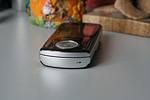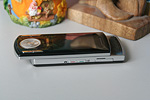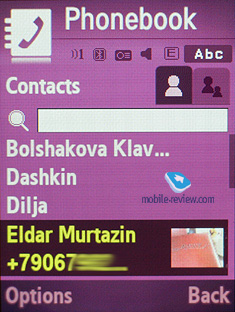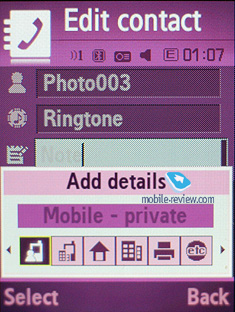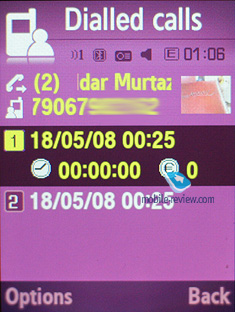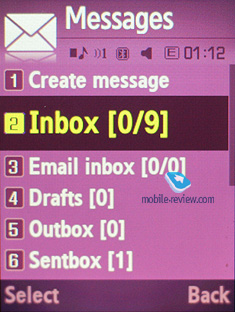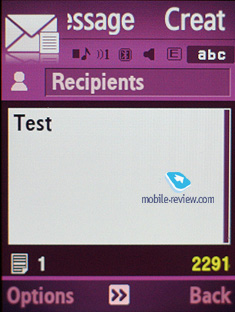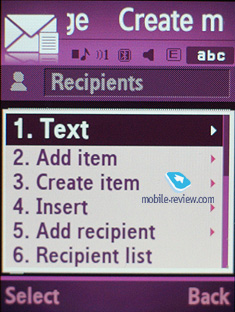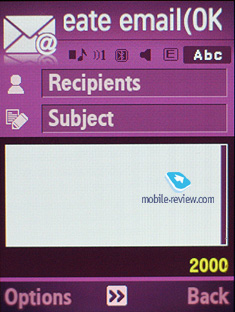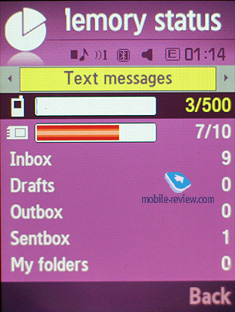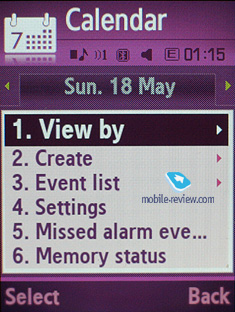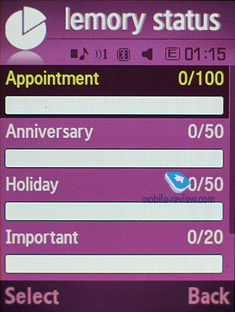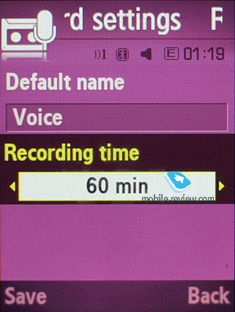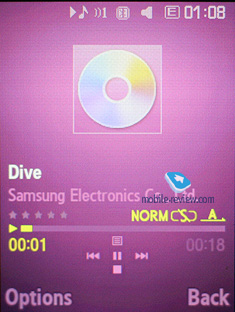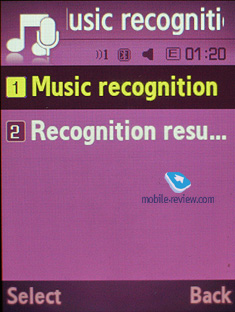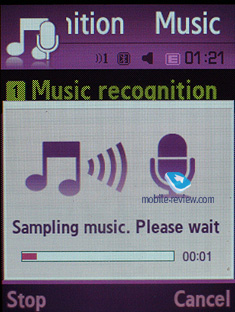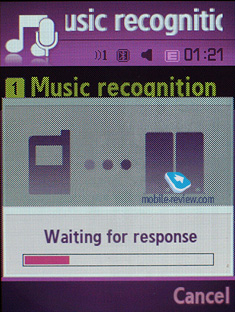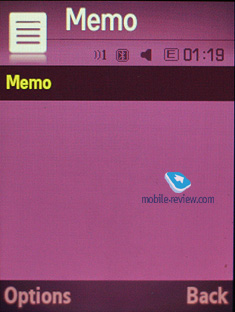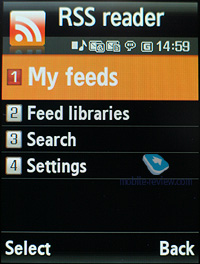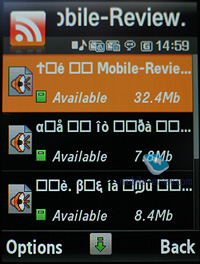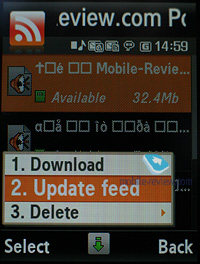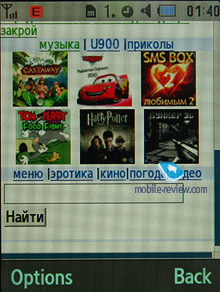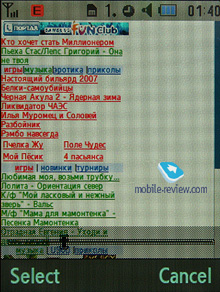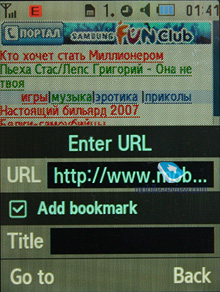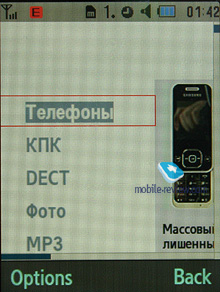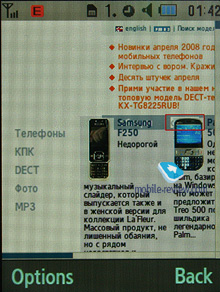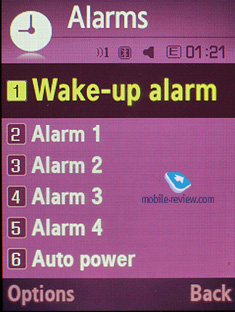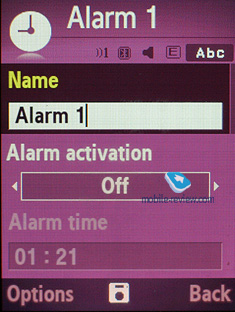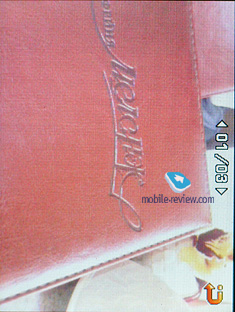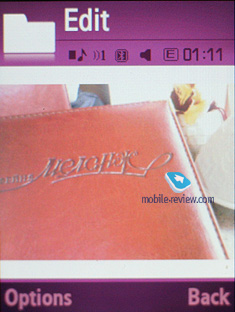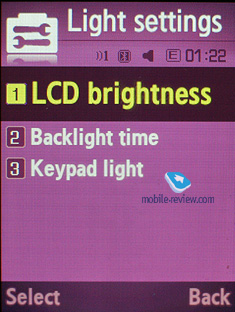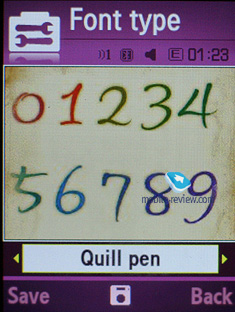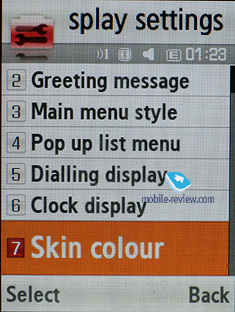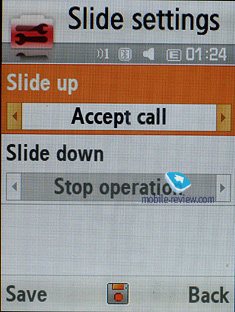|
|
Review of GSM/UMTS-handset Samsung F400
Live photos of Samsung F400
Table of contents:
- Positioning
- Design, size, controls
- Display
- Keypad
- Battery
- Connectivity
- Memory, Memory cards
- Performance
- Camera
- Menu and User Interface
- Phonebook
- Call list
- Messaging
- Organizer
- Multimedia
- MP3-player
- Entertainment
- Applications
- WAP
- Alarm clock
- File Manager (My files)
- Settings
- Impressions
Sales package:
- Handset
- Charger
- Wired headset with a 3.5mm plug
- USB data cable
- 512 Mb memory card (size and availability vary by region)
- User Guide
Positioning
The F400 extends Samsung’s cooperation with Bang&Olufsen, which is the primary reason for all this PR fuss around their new music playing product. But while this manufacturer employs a pretty solid hardware platform, its specialist music phones are less fetching than the competition despite sporting pretty decent audio quality. They simply can’t bring them into the mainstream, as consumers go rather for Samsung’s convergent devices, rather than music-centric offerings, such as the F330 and F250. While it’s obvious that they need to attract more attention to this segment, the company itself doesn’t want its sales to rocket up, for this phone are way too quaint. In fact, only the grands of the industry can afford to advertise their new ideas via commercial products – Samsung has done this before, and Nokia is no stranger to this approach either.
The stumbling rock in this matter is whether the Bang&Olufsen brand is of any value to the average consumer, whether they know it or not. Unfortunately, on most markets the answer is negative. This brand enjoys modest sales in the “not-for-all” segment is generally tries to tout its consumer electronics as some sort of exclusive items building upon their design. But in my humble opinion what characterizes B&O best is lack of any connection between their products. To put it differently, they keep churning out one-offs that don’t complement each other in any way, so that you end up buying some specific TV’s design, rather than that of a whole series that evolves over time. For example, I have a soft spot for Sony’s consumer electronics, as even a few years after the release of some original product they don’t just put its sketches away, but keep offering new solutions that take design cues from it. However, while most makes sway towards substance over style, in B&O’s case it’s other way around – they give functionality a short shrift and focus all their efforts on shaping something really offbeat. That’s why many B&O-branded devices I had a chance to play around with were designed with everything but usability and user experience in mind. They all were more of their owner’s statement that he or she could afford such a toy – for instance, they DECT-phones look gorgeous, but are extremely fiddly and awkward to use. Although on a rare occasions B&O’s designers back down and create products that pretend to be normal, like their TVs. But in this case the reason is quite clear-cut – should they mould some really astonishing, yet bizarre-to-use controls, nobody will ever buy such a thing.
Thankfully, the Samsung F400’s design is all on Samsung designers’ account. In fact this was the only right way to go, since the sales of Samsung’s and B&O’s joint project, Serene, were so miserable, even in the segment it played, that they could easily make one wonder why would they need to roll it out at all. Probably to show the world that Samsung can make phones like this too, but that’s pretty much about it. For its F400 Samsung has borrowed B&O’s expertise in audio, since the market believes this maker has a lot to offer when it comes to sonic experience. It’s the kind of stereotype that’s widely adopted among consumers who are not bent on electronics; and actually this is the right kind that’s worth utilizing and all, but it’s quite another matter that it makes no big difference bar a discernible label on the front.


Perhaps that’s why Samsung has decided to launch the F270, whose only difference from the F400 lies in the shape of its loudspeakers (and absence of the B&O branding). Furthermore, in terms of price they the gap between them is really miniscule – 30 Euros or so; the question is, does this B&O fuss cost so little? We are not sure about this, but it seems so. Indeed, there are no bells and whistles inside this phone, nor does it different from other mass-market offerings in any other way, plus the sound system designed by B&O brings nothing new to the table in the sense of user experience, it can’t even outrun Nokia’s phones on this front.

The bottom line on the F400’s positioning is this – if you have heard somewhere that “B&O is good”, but never tried or didn’t have a chance to buy their products, then you are the F400’s audience. In other words, it’s an attempt to exploit B&O's image and reputation on the mass-market. While it’s a good move on Samsung’s account, it won’t boost this handset’s sales. And for B&O it’s quite the contrary – the F400 signifies that they are currently experiencing certain difficulties, being unable to grow beyond the limits of such a narrow niche.
Back to the table of contents >>>
Design, size, controls
Since the F400 is a music playing phone, they’ve armed it with the much-hyped dual-slider mechanism, meaning that you can pull the top potion up and get access to the phone’s numeric keypad, or slide it down and see its loudspeakers. Apparently, being so close together these speakers won’t give you stereo effect. Phones with a better placement of speakers have them mounted on the sides, or, at very least, on the top and bottom edges.






The F400’s build quality is nothing to grumble about; it’s made entirely of plastic. It doesn’t creak or feel wobbly in the hand; all in all it’s pretty solid. It’s somewhat larger than the market’s average handset and sways more towards the camp of S60-powered smartphones at 99.9x48x14.5 mm. Curiously, smartphones have dropped a few grams off lately, whereas the likes of the F400 have, on the contrary, gained some. This way, the F400 tips our scales at 102 g, being pretty palm-friendly, plus it has its rear finished in soft touch that adds to its overall comfort.
Video: looks and menu (wmv, 22,7 mb) >>>




While its front plate is a glossy fingerprint magnet, smudge and face grease keep a low profile on it. Topping the display is the forward-facing camera for video calls. On the left there is a lanyard eyelet along with the volume rocker and microSD memory expansion slot, covered by a plastic flap. Flipping over to the right-hand spine you will find the interface connector as well as the dedicated audio key and camera shutter. Perched on the top is the 3.5 mm headset jack. Completing the F400’s exterior is the camera lens and flash on the back of the phone.




Back to the table of contents >>>
Display
The handset makes use of a 2.2 inch TFT display (34x46 mm) with a resolution of 240x320 pixels showing up to 262 K colors. Specs-wise, the F400’s display is no different from the Samsung U900 but for some reason its colors have suffered a bit – they aren’t as vivid and juicy, and the picture doesn’t look that sharp. Indoors the F400 outputs a bright, juicy image; overall, it is one of the market’s best offerings. Outdoors we found that the F400's screen got washed out, was not as bright and occasionally we had to stare at it to read information.
The display accommodates up to 9 text and 3 service lines. All fonts are large and very readable; the same goes for SMS and dialing screen.

Back to the table of contents >>>
Keypad
The F400’s keypad is made of plastic and features mid-sized and well-spaced buttons. That’s all we can about it, however – it doesn’t have any serious failings, but it’s not the most convenient keypad we’ve come across either. All keys are lit in reasonably dim blue that does the job well enough.



The handset’s soft-keys are mechanical (not touch-sensitive) and positioned more towards the edges, so occasionally you will end up tapping their captions, which is frustrating. The F400 also boasts a four-way navigation key with a scrolling wheel, which is of no real use, though – the side-mounted volume controls are handier when it comes to adjust the volume level, and jumping between channels can be done via the navi-pad just as well. But the F400 is a music-minded phone after all, so they simply had to add some special flavor to it.


Back to the table of contents >>>
Battery
The handset utilizes a 800 mAh Li-Ion cell. The maker F400’s cell as being good for up to 240 hours of standby and 3 hours of talk time. Within European networks the phone lasted around 2 days (45 minutes of calls total and around two hours of music). At the same time, in Moscow it managed to stay online for 2 days at one hour of calls. That’s why the F400 will stay up and running for at least 2 days with average load, however under certain circumstances you might squeeze up to 3 days of operation out of it. It takes the handset 2 hours to charge from empty to full. No higher-capacity cells are available for this model.

We managed to get 11.5 hours of non-stop music from the F400 (radio module on) with the highest volume settings and bundled headset plugged in.
Back to the table of contents >>>
Connectivity
Bluetooth. The model supports various profiles, such as Headset, Handsfree, Serial Port, Dial Up Networking, File Transfer, Object Push, Basic Printing, A2DP, Dual Profile Bluetooth. EDR-enabled Bluetooth 2.0 is onboard. Headset management doesn’t allow us to have any quibbles with it, everything is standard here.
USB-connection. In the menu you may select one of three modes: Media, Mass Storage, Samsung PC Studio. When connected to a PC via USB, the F400 automatically recharges itself.
While in the USB Mass Storage mode, the F400 shows up on the desktop without requiring you to install any additional drivers, so right after plugging in it’s ready to work. Data connection speeds top out at 950 Kb/s.
You won’t be able to use the F400’s Bluetooth connectivity along with USB – it will require you to disable Bluetooth regardless of its status (connected and transferring data or not), which is very awkward.
There is also EDGE class 10 connectivity for GSM networks.
Back to the table of contents >>>
Memory, Memory cards
The phone ships with 128 Mb of onboard memory – this storage space, give or take, is available to the user right out of the box. The memory card (hot-swappable) is displayed as a separate section, so you can’t access both memory types at a time. The F400 also comes with a file manager, enabling you to copy files to/from the memory card. In our test the handset had no problems handling a 8 Gb microSD memory card. The F400 ships with a 512 Mb memory card.
Back to the table of contents >>>
Performance
The F400’s performance is very typical as far as Samsung’s current device generation is concerned and is pretty moderate, although, on the other hand, we could hardly demand more from a product of this class. As it stands today, new applications can be uploaded only over the air (wap). Java apps can’t exceed 300 Kb in size.
Back to the table of contents >>>
Camera
The handset utilizes a 3 Mpix CMOS autofocus-enabled module. The camera application enjoys the landscape layout, otherwise shooting with you would’ve been a pain. Various shortcuts pop up right on the navigation screen, including Macro Mode, Flash, Timer and Exposure. Since the numberpad is always exposed when shooting, you will be able to use the buttons over there as shortcuts too.

The camera supports the following resolutions:
- 2048x1536 (3M)
- 1600x1200 (2M)
- 1280x960 (1.3M)
- 640x480
- 320x240
Several shooting modes are at your disposal:
- Single shot – default mode, the phone takes one shot at a time;
- Multi-shot – the phone takes a couple of shots in rapid succession (6, 9 or 15, two speeds, image resolution gets scaled down to VGA automatically);
- Mosaic shot – the F400 features a variety of mosaic shot types (image resolution gets scaled down to VGA automatically);
- Frame shot – while the resolution drops, you get access to the set of preinstalled frames;
- Panorama – the device can stitche together all parts of panorama on its own.
Other settings include special effects (Grey, Sepia, Negative) and timer (3, 5 or 10 seconds). The LED flash is not particularly bright, but it does the job. It is quite another matter, though that shots taken in the dark are far from decent, as the matrix obviously lacks sensitivity.
The F400’s camera is pretty average as far as its specs are concerned, but since it’s a music device we can’t really berate it much – we also were pretty content with the quality it provided on a sunny day.
 |
 |
| (+) maximize, 2048x1520, JPEG |
(+) maximize, 2048x1520, JPEG |
 |
 |
| (+) maximize, 2048x1520, JPEG |
(+) maximize, 2048x1520, JPEG |
 |
 |
| (+) maximize, 2048x1520, JPEG |
(+) maximize, 2048x1520, JPEG |
 |
 |
| (+) maximize, 2048x1520, JPEG |
(+) maximize, 2048x1520, JPEG |
 |
 |
| (+) maximize, 2048x1520, JPEG |
(+) maximize, 2048x1520, JPEG |
 |
 |
| (+) maximize, 2048x1520, JPEG |
(+) maximize, 2048x1520, JPEG |
 |
 |
| (+) maximize, 2048x1520, JPEG |
(+) maximize, 2048x1520, JPEG |
Video. For videos the F400 proposes exactly the same pool of effects as for the single shot mode, plus most settings are identical, bar the resolutions, there are only two available for the video mode: 320x240 pixels and 176x144 pixels (15 FPS). Maximum clip duration – up to 1 hour. Unfortunately, the F400 can’t shoot videos in VGA and in QVGA it does its job at a very marginal frame rate.
Video sample (mp4, 0,9 mb) >>>
Back to the table of contents >>>
Menu and User Interface
Much like other music-minded phones, with the F400 you can call up a quick launch music menu (radio, music player, video player) by sliding the top portion of the phone down. However given that it also has a side-mounted dedicated music key, this menu isn’t of much use.
The F400’s main menu is shown as a 3x4 grid with all sub-menus enjoying horizontally-arranged lists; plus the phone’s submenus are displayed in pop-up windows when navigating through the menu, so that you can soar straight to the feature you need. While surfing the menus you can take advantage of last item memorization in every sub-menu and the main menu. The handset will “remember” which function you addressed last time, and will highlight it automatically next time you enter the same menu item. For example, if you had selected call list in main menu and done some operations in it, then the next time you enter main menu you will have it highlighted in first place. But that’s not all; once you access it again you will see that sub-menu item which was addressed last will be highlighted too. When hovering over one or another item in the list you will see it highlighted, and the font size - increased.
Shortcut number navigation is supported, but there are more ways to navigate the menu in the F400. You can bind four different applications from the list, offered by manufacturer (you will not be able to bind java applications). There is no quick launch menu available in the F400 (uMenu).
Living World. This is a selection of personal wallpapers for each country (major cities might get unique wallpapers in the future, though it is not quite evident). When you will be in Moscow you will see Kremlin wharf and triumphal arch in case you’re in Paris, as for London – house of parliaments, and so on. Besides graphical assignation manufacturer decided to modify wallpaper depending on time of day: in the morning you see sun, and in the evening you see blinding lights of Kremlin wharf, cars will have their headlights turned on.

Time is not the only event that can be morphed into graphics. For example network reception level: good signal – sky is blue, no signal or weak one – sky is covered with clouds. At first you don’t pay much attention to this tiny feature, but after a month you will look on the sky instead of the standard bar.
For new messages, missed events, or alarm clocks there is a special way of displaying, and which is powered with standard, traditional pop-up window with text. In daytime, such events will be demonstrated with help of airplane that will fly through the sky, and in the evening that would be fireworks. Color will change according to event type. At a glance this system looks kind of complicated, especially during its description, but in reality it is crystal clear and understandable.
When dialing a number you will see a small image with main theme displayed and animation of the dialed number.
Back to the table of contents >>>
Phonebook
Contacts can be accessed by pressing right soft key; you will see a list that contains all entries from both SIM-card and phone’s memory. The second tab comprises contact groups, so that you can switch to them in no time. If there is an assigned image, its thumbnail will be shown in the list – when scrolling though your contact list, a thumbnail will be shown only for a currently selected entry, and if there is none set, the F400 will use a default smilie.
The field beneath the name is the default number, which can be picked manually from the list of submitted numbers for a particular contact. Quick name search by first letters is supported; there can be up to twenty of those, for any language. Once you press OK key you will go into detailed view of the selected entry. There you will see a thumbnail, if any. It can be an image, a photo or a video clip. Each entry can have up to 5 phone numbers of different types (mobile, office, home, fax other), one of them will be main number (by default it is the first one you entered). Fiels aren’t fixed, meaning that you can choose their type manually (for example, submit two mobile and two home numbers for some contact).
There are two lines for First Name and Last Name (search is performed only by the former), these fields get merged when displayed in the general list, and First Name comes first. For example Eldar Murtazin will be shown only in this order. Length of each field is 20 characters for any supported input language. You can also switch languages on the fly when entering a name.
All entries, regardless of language, are sorted out in the following way – all contacts with headings made in a local language (Russian, for example) go first and then those with names in English. This is rather convenient and handy list sorting system. Taking into account fast language switch option during the search, it’s clear that no language will spoil the experience of working with this phone. The list can’t be sorted by first or last name.
But let us return to the information entered for a contact. Apart from phone numbers, e-mail address (there may be several of them), a little text memo, address and other fields can be submitted on top of all that. Any music file (including MP3) can be picked as a ring tone for a contact. Three caller groups are provided by default with the possibility for creating any number of additional groups, setting a personal melody and image for each (by default there are three groups). SMS alerts are not customizable.
The phonebook is capable of holding up to 1000 contacts with filled in data fields. Even if all the available blanks are not used, the cap won’t get any bigger and will still make one thousand. It is possible to specify in the settings where all new numbers should be kept by default. There is also an option for moving entries from the SIM-card, although the reverse action is denied. According to the developers, PC (MS Outlook in particular) is best for data synchronization with the F400. Any contact in the form of SMS/MMS, mail message or other text file can be quickly sent through Bluetooth to another device. There are no problems with sending, and the phonebook entry gets beamed to another device, where it is read without any trouble.
The phonebook may contain a business card as well, though its structure copies all the fields found in a regular contact in the phone book.
There can be up to eight numbers in the fast dial list; separate numbers tied up with a single contact may appear on this list as well. The chosen entry (not of the phone number type) is displayed on the buttons as the subtitle. In case the contact you have picked has an image attached to it, then you won’t see the entry’s name, which may get annoying when you have two different numbers of one contact mapped.
You can create any number of caller groups, assign up to 20 contacts and customize them with a picture and tune.
On an incoming call, caller ID picture occupies not the entire screen, but only a part of it. However, it still takes up a considerable area. This isn’t great, given the display’s stellar specifications.
Back to the table of contents >>>
Call list
Each of the given lists contains up to 30 phone numbers. There is a combined list of all the last calls with an icon indicating call type. Pressing the navi-pad horizontally, you can switch quickly between the lists. The date and time of the calls with a special note on duration are displayed in the extended view for separate entries. Calls from/to one number are grouped up, so that the number standing next to the call specifies total number of calls made. In order to access duration data you will need to call up detailed information on desired item. As always, the overall time of the calls and their cost can be viewed in this menu (in the case that the service has been enabled).
For individual numbers you can arrange a black list, which will reject all calls coming from these contacts.
Back to the table of contents >>>
Messaging
Much like other makers, over at Samsung they have forgone that artificial division into SMS-MMS types – you just start composing a message, and only then, depending on the contents, it is attributed to SMS or MMS. The menu still holds an option for switching message into MMS mode (for example when you need to send only text, but to an e-mail address, without calling up the bundled client).
The phone memory can hold up to as many as 500 messages; the handset supports EMS standard compatible with Nokia Smart Messaging. T9 text input comes in handy and is easy to use. While choosing recipient, you can either select a telephone number from your contacts or pick one from the call lists or groups. All messages are manageable, this means you are at liberty to move a certain number to your black list, in order to make sure all messages coming from that phone number will be deleted automatically; possibility for moving messages to any own folder is also at your disposal. For e-mail you can move not only addresses to the blacklist, but unwanted subjects as well.
There are no size restrictions set on received messages, though an outgoing message’s size is limited to 295 KB. As for additional services available with the F400, message rejection and message retrieval type options are onboard. All messages are stored in general dynamic memory, the same goes for e-mails.
Also there is a useful function for sending SOS-messages – when activated, should you find yourself in an emergency, after pressing the volume key four times, the message «I am in emergency. Please help me» will be sent to contacts submitted earlier, all incoming calls from these numbers upon sending the emergency message will be picked up automatically. Recipients (not more than 5), as well as number of Repeats may be set up manually, while text of the SOS-message is not customizable.
The bundled mail client is standard in all its components – 5 accounts and the maximum of 100 incoming messages; attachments are also handled by the phone, though there are also several caps – there’s no way you can receive a file more than 500 Kb big, or send one with size exceeding 300 kb. Received files can be viewed via the bundled browser. The F400 doesn't support html in emails, which breaks formatting of most letters you receive, so they become really awkward to read. The mail client found in Samsung-branded phones is now falling behind those embedded in Nokia’s and Sony Ericsson’s solutions.

Back to the table of contents >>>
Organizer
The phone’s memory can store as many as 100 events of one type – meeting. There are other event types as well, like anniversary and holiday, with the maximum capability of 50 events for each type. The F400 can also hold up to 20 high-priority events and the same number of private entries.
Day and time as well as end time of an event are indicated for each entry. Alert signal and its duration can be adjusted to your liking; repeatable events are available for setting up (repeat time is also manageable as well as the exceptions). The weekly and the monthly calendar views are very convenient with each type of the event having its own color.
Speaking of the organizer’s shortcomings, I cannot overlook the fact that when typing date and time for an event, the end time doesn’t change, which badly hurts its ease of use – other manufacturers make the due time shift automatically (by default any event takes one hour).
Back to the table of contents >>>
Multimedia
FM-radio. You can store up to 50 radio stations in the memory; the range of available frequencies is 87.5-108 MHz. Also, you can enjoy auto-tuning, but particular channels cannot have own names attached – they are always shown as the frequency numbers. The radio can work in handsfree mode, plus it enables you to set it up as an alarm clock, but regardless of how you are going to use it, a plugged-in headset is a must, since it doubles as an antenna. The radio implementation is fine, although it doesn’t pick up all stations equally well, but on balance, it is quite competent in comparison to other vendors’ offerings. The radio can be minimized.
RDS here displays only the station’s name in the general list, no advanced options available.
Voice recorder. You can record up to several hours of voice memos with the number of files being unlimited. Basically, limitations on recording duration are set by the user himself, though length of a single recording cannot exceed 1 hour. All the files are stored in a separate folder in the memory bank. The recorder performs well during lectures, conferences and presentations – I could even say that it is a partial substitute for a digital tape recorder.

Back to the table of contents >>>
MP3-player
The integrated mp3 player, supporting random, sequential and cyclic playback, is available on the phone. Mp3 files can be uploaded onto the handset both directly over Bluetooth and through the synch application or Windows Media Player. There are no limitations placed on tags and names of music files. Bitrates are also not something that really matters – the handset easily deals with all available formats and supports WMA, AAC, eAAC, eAAC+.
The title of the currently played back track is displayed as well as the number of the remaining tracks. The F400 also packs in a non-adjustable equalizer with 9 presets available. Among new additions is the Fade Out option, when towards the end of every track the sound will… well, fade out. Your tracks can be played through the stereo headset as well as the speakerphone. The volume bar has 14 scales on it. And of course the user can make up their own playlists. Player can work in minimized mode – in this case the display will show current track title and music controls, which is a good thing.
The player boasts the following filters: all tracks, recently players, most popular, artists, albums, genres and composers. The F400 also sports Album Arts support.
Speaking of new options, the player has obtained the rating system, enabling you to award any track with one to five stars. The maker has driven the integration with Windows Media Player as deep as it has never been before; actually, this manager also sports the rating system.
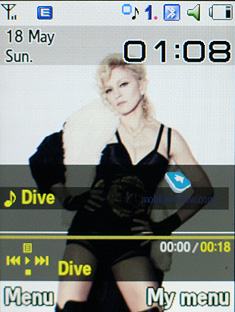
The bundled headset has a jack for plugging in own earphones and provides quite adequate sonic experience. In terms of audio quality, the F400 is a pretty decent choice, although it’s little to no different from Samsung’s generic music phones on this phone. It also packs in a 3.5mm audio jacket that allows you to plug in custom earphones.
Music Recognition – this service allows the phone to identify audio clips recorded via the phone’s microphone or radio. All in all, it’s pretty similar to Sony Ericsson’s TrackID and also does a good job at digging out song names and artists for you.
Alexnader Dembovsky’s take on the Samsung F400:
The presence of Bang&Olufsen’s ICEpower amplifier (there is a special mention of it on the F400’s back) hasn’t gone amiss. Not that we had really strong doubts about it, but we were pretty skeptical in the first place, since most tools of this sort, be it hardware or software, usually do nothing beyond a couple of facelifts and minor improvements here and there instead of enhancing sonic experience for real. But thankfully, all is right with the F400’s sound, as it can well replace a pretty solid stand-alone music player, at least in terms of audio quality. Its frequency response graph is smooth for a phone with very few peaks and dips. Other parameters were okay too, and we found nothing to fault the F400 for.
We were also pleased by its output signal strength, which was much higher than average for mobile phones, thus allowing for a wider selection of earphones we could plug into the F400. And the standard 3.5 mm audio jack is also something we’d like to note here.
General performance
| Frequency response (from 40 Hz to 15 kHz), dB: |
+0.09, -0.58 | Good |
| Noise level, dB (A): |
-87.6 | Good |
| Dynamic range, dB (A): |
83.4 | Good |
| THD, %: |
0.170 | Average |
| IMD, %: |
0.319 | Average |
| Stereo crosstalk, dB: |
-82.9 | Very good |
| Intermodulation at 10 kHz, %: |
0.309 | Average |
General performance - Good
Frequency response

Noise level

Back to the table of contents >>>
Entertainment
Games – the handset comes preinstalled with three games, which are all demos (you will have to shell out for their full versions), these are: Aspalt2, Minigolf Las Vegas, Paris Hilton Diamond Quest, Tetris Mania. There is an unlimited amount of memory assigned to Java-applications, plus you can remove any of the pre-installed games and upload new over the air (via WAP). Heap size can’t exceed 2 Mb, while the application can’t go over 300 Kb.
Image editor. A basic picture editor, which allows transforming images by using a variety of tools.
Back to the table of contents >>>
Applications
World time is displayed for two chosen cities.
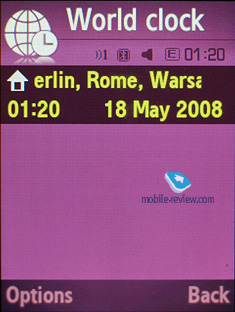
Calculator It divides, multiplies, subtracts and adds and does several more things – quite enough for a mobile calculator.
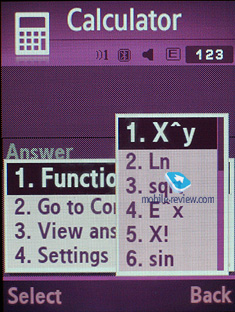
With the converter, you can operate with different units of measurements as well as with a number of currencies.
Countdown time and stopwatch have no bells and whistles.
Memo – standard text notes.
RSS Reader. This is a stand-alone utility for RSS feeds. However, it would make more sense if the RSS Reader was bound up with the web-browser, but this is not the case with the F400. This way, RSS links are not picked up by the browser, or sent directly to the application. You will need to manually submit a channel address in this app to subscribe, or enter a web address and let the application try to find an RSS channel on it.
While uploading your news feed, the F400 can upload text, as well as video and audio files, and it is up to you to set the size limit (by default – 5 Mb per file). Regrettably, there are no scheduled feed updates available, thus you will need to refresh the feed manually every time you need hot news.
Obviously with this application Samsung is having a first go at this field, and the truth is, it is not really functional or appealing the way it is in the F400. Similar solutions found in the phone from other makers pack more punch and are easier to manage.
Back to the table of contents >>>
WAP
The handset comes with a wap-browser version 2.0 (NetFront 3.4), where apart from JavaScript support, fonts scaling (three types), Smart-Fit (single-column view), full-screen mode (all controls are hidden), page caching, they have embedded a new feature – on-screen ‘mouse’ pointer. Much like Nokia’s S60-powered handsets and Opera Mini, you can view pages with a tiny navigation window displayed. The browser itself packs a lot of goods under the hood and will be appreciated by most users.
Unlike the previous models, which used Picsel Viewer for browsing office documents, the F400 employs the bundled browser for these purposes. What we really like about it is that the user can perform local search within a document (any language). While it is a tad sluggish compared to Picsel Viewer, it is still pretty easy to handle. Personally, I couldn’t make up my mind on which solution I liked better – both of them have their strengths and weaknesses.
Back to the table of contents >>>
Alarm clock
The handset comes equipped with five alarm clocks, each of them can go off on certain weekdays. You can also pick one of the five tunes, or turn to MP3 tracks. In settings it is possible to enable auto power-up when any event triggers.
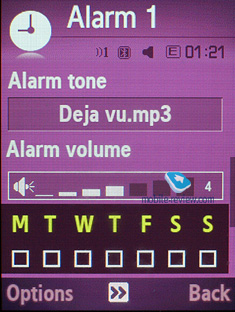
Back to the table of contents >>>
File Manager (My files)
That’s the place to search for all files such as music, pictures, video and sounds. Any uploaded file gets stored here. The disadvantage is that files sometimes are not displayed in the list immediately - in that case you will need to leave the menu and enter it again.

Files and folders can be viewed either as a list or thumbnails. You can mark any number of files. The handset supports Move, Copy and Delete operations, as well as various types of sorting (by type, name or size).
Memory card’s file structure is a slightly different story, as it can be accessed through the main menu, where each item features “Memory card” option.
The F400’s new feature is support for ShoZu that allows uploading any type of multimedia content to blogs – all it requires you to do is submit your logins and passwords to the services you use and then the handset will do the rest, enabling you to release, say, videos or photos right to you personal blog.
Back to the table of contents >>>
Settings
Traditionally this item boasts a standard set of options inside like password protection of selected sections (messages, short messages, organizer, etc.), backlighting duration and brightness, dialing display settings (no custom animations are available, one is assigned to the default theme – Living World).
Keypad light – there are three options at your disposal, one of them is Night mode, implying that backlighting will be active only between 5:00 PM and 9:00 AM and disabled during daytime. If you come to think of it, this feature is nothing more but an illusive replacement for ambient light indicator, which Motorola’s handsets are armed with.
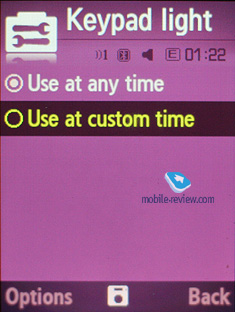
Profiles – the F400 comes with a full-fledged profile system that includes the Flight Mode. Every profile is customizable – you can pick ring tone, incoming message alert and adjust the volume level.
Mobile Tracker – submit a phone number, where notifications will be sent to in case SIM-card was changed – that message will contain number of the SIM-card being used with the handset. This section is protected with password, so that no one other than you or someone else who knows the password could disable the Tracker. Should your device have the SIM-card switched once, the specified number will receive one message instantly, and one more each time a new card is plugged in. A fetching feature which can prove to be of much help in case the handset is lost or stolen.
Apart from the standard set of wallpapers for the standby screen, you can make up animated wallpapers of your own, and it doesn’t take a rocket scientist to create one. All you need are 9 snaps, then you adjust time spans between different frames and transition effects (there is a slew of them available, like Butterfly, Paper place etc). And the animation you get is pretty amusing; it will work on the standby screen as long as the display is on.
Back to the table of contents >>>
Impressions
The reception quality put up by the F400 is in line with other Samsung-branded devices. The ringtone volume is quite decent, as it can be heard in various environments. The silent alert is average strength-wise, no significant improvements have been made here.
Retailing for as much as 350 Euro, the F400 is not the device to look out for – it’s pretty steep and doesn’t offer any substantial advantages compared to other Samsung-branded phones, plus there is not much to leverage as far as B&O’s branding is concerned. All in all, it’s a typical niche solution, to be really specific, the F400 is an ultra-niche phone that won’t be really popular. Samsung seem to struggle with every music phone they churn out, as they can’t find what unique traits and feats will make all the difference and set their phones apart from the competition.
Related links:
Back to the table of contents >>>
Eldar Murtazin (eldar@mobile-review.com)
Translated by Oleg Kononosov (oleg.kononosov@mobile-review.com)
Published — 26 June 2008
Have something to add?! Write us... eldar@mobile-review.com
|
News:
[ 31-07 16:21 ]Sir Jony Ive: Apple Isn't In It For The Money
[ 31-07 13:34 ]Video: Nokia Designer Interviews
[ 31-07 13:10 ]RIM To Layoff 3,000 More Employees
[ 30-07 20:59 ]Video: iPhone 5 Housing Shown Off
[ 30-07 19:12 ]Android Fortunes Decline In U.S.
[ 25-07 16:18 ]Why Apple Is Suing Samsung?
[ 25-07 15:53 ]A Few Choice Quotes About Apple ... By Samsung
[ 23-07 20:25 ]Russian iOS Hacker Calls It A Day
[ 23-07 17:40 ]Video: It's Still Not Out, But Galaxy Note 10.1 Gets An Ad
[ 19-07 19:10 ]Another Loss For Nokia: $1 Billion Down In Q2
[ 19-07 17:22 ]British Judge Orders Apple To Run Ads Saying Samsung Did Not Copy Them
[ 19-07 16:57 ]iPhone 5 To Feature Nano-SIM Cards
[ 18-07 14:20 ]What The iPad Could Have Looked Like ...
[ 18-07 13:25 ]App Store Hack Is Still Going Strong Despite Apple's Best Efforts
[ 13-07 12:34 ]Infographic: The (Hypothetical) Sale Of RIM
[ 13-07 11:10 ]Video: iPhone Hacker Makes In-App Purchases Free
[ 12-07 19:50 ]iPhone 5 Images Leak Again
[ 12-07 17:51 ]Android Takes 50%+ Of U.S. And Europe
[ 11-07 16:02 ]Apple Involved In 60% Of Patent Suits
[ 11-07 13:14 ]Video: Kindle Fire Gets A Jelly Bean
Subscribe
|




